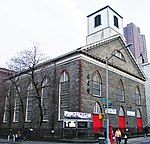Klughaus Gallery
2011 establishments in New York CityArt museums and galleries in ManhattanContemporary art galleries in the United StatesUnited States art museum and gallery stubsUse mdy dates from March 2015
Klughaus Gallery is an art gallery and agency based in New York City that exhibits and represents artists with roots in graffiti and street culture.
Excerpt from the Wikipedia article Klughaus Gallery (License: CC BY-SA 3.0, Authors).Klughaus Gallery
Market Street, New York Manhattan
Geographical coordinates (GPS) Address Nearby Places Show on map
Geographical coordinates (GPS)
| Latitude | Longitude |
|---|---|
| N 40.711991 ° | E -73.994443 ° |
Address
Market Street 47
10002 New York, Manhattan
New York, United States
Open on Google Maps





